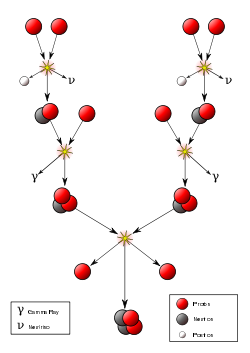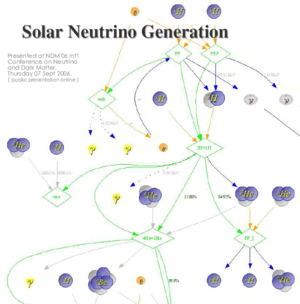Proton-proton chain reaction
The proton-proton chain reaction is one of several fusion reactions by which stars convert hydrogen to helium, the primary alternative being the CNO cycle. The proton-proton chain dominates in stars the size of the Sun or smaller.
Overcoming electrostatic repulsion between two hydrogen nuclei requires a large amount of energy, and this reaction takes an average of 109 years to complete at the temperature of the Sun's core. Because of the slowness of this reaction the Sun is still shining; if it were faster, the Sun would have exhausted its hydrogen long ago.
In general, proton-proton fusion can occur only if the temperature (i.e. kinetic energy) of the protons is high enough to overcome their mutual Coulomb repulsion. The theory that proton-proton reactions were the basic principle by which the Sun and other stars burn was advocated by Arthur Stanley Eddington in the 1920s. At the time, the temperature of the Sun was considered too low to overcome the Coulomb barrier. After the development of quantum mechanics, it was discovered that tunneling of the wavefunctions of the protons through the repulsive barrier allows for fusion at a lower temperature than the classical prediction.
Contents |
The pp chain reaction

The first step involves the fusion of two hydrogen nuclei 1H (protons) into deuterium, releasing a positron and a neutrino as one proton changes into a neutron.
This first step is extremely slow, both because the protons have to tunnel through the Coulomb barrier and because it depends on weak interactions.
The positron immediately annihilates with an electron, and their mass energy is carried off by two gamma ray photons.
After this, the deuterium produced in the first stage can fuse with another hydrogen to produce a light isotope of helium, 3He:
From here there are three possible paths to generate helium isotope 4He. In pp I helium-4 comes from fusing two of the helium-3 nuclei produced; the pp II and pp III branches fuse 3He with a pre-existing 4He to make Beryllium. In the Sun, branch pp I takes place with a frequency of 86%, pp II with 14% and pp III with 0.11%. There is also an extremely rare pp IV branch.
The pp I branch
-
32He + 32He → 42He + 2 1H + 12.86 MeV
The complete pp I chain reaction releases a net energy of 26.7 MeV. The pp I branch is dominant at temperatures of 10 to 14 megakelvins (MK). Below 10 MK, the PP chain does not produce much 4He.
The pp II branch
-
32He + 42He → 74Be + γ 74Be + e− → 73Li + νe + 0.861 MeV / 0.383 MeV 73Li + 1H → 2 42He - See also: lithium burning
The pp II branch is dominant at temperatures of 14 to 23 MK.
90% of the neutrinos produced in the reaction 7Be(e−,νe)7Li* carry an energy of 0.861 MeV, while the remaining 10% carry 0.383 MeV (depending on whether lithium-7 is in the ground state or an excited state, respectively).
The pp III branch
The pp III chain is dominant if the temperature exceeds 23 MK.
The pp III chain is not a major source of energy in the Sun (only 0.11%), but was very important in the solar neutrino problem because it generates very high energy neutrinos (up to 14.06 MeV).
The pp IV or Hep
This reaction is predicted but has never been observed due to its great rarity (about 0.3 parts per million in the Sun). In this reaction, Helium-3 reacts directly with a proton to give helium-4, with an even higher possible neutrino energy (up to 18.8 MeV).
Energy release
Comparing the mass of the final helium-4 atom with the masses of the four protons reveals that 0.007 or 0.7% of the mass of the original protons has been lost. This mass has been converted into energy, in the form of gamma rays and neutrinos released during each of the individual reactions. The total energy we get in one whole chain is 26.73 MeV.
Only energy released as gamma rays will interact with electrons and protons and heat the interior of the Sun. This heating supports the Sun and prevents it from collapsing under its own weight.
Neutrinos do not interact significantly with matter and do not help support the Sun against gravitational collapse. The neutrinos in the ppI, ppII and ppIII chains carry away the 2.0%, 4.0% and 28.3% of the energy respectively.[1]
The pep reaction

Deuterium can also be produced by the rare pep (proton-electron-proton) reaction (electron capture):
In the Sun, the frequency ratio of the pep reaction versus the pp reaction is 1:400. However, the neutrinos released by the pep reaction are far more energetic: while neutrinos produced in the first step of the pp reaction range in energy up to 0.42 MeV, the pep reaction produces sharp-energy-line neutrinos of 1.44 MeV.
Both the pep and pp reactions can be seen as two different Feynman representations of the same basic interaction, where the electron passes to the right side of the reaction as an anti-electron. This is represented in the figure of proton-proton and electron-capture chain reactions in a star, available at the NDM'06 web site.[2]
References
- ↑ Claus E. Rolfs, William S. Rodney: Cauldrons in the Cosmos, The University of Chicago Press, 1988, 354. pp
- ↑ Int'l Conference on Neutrino and Dark Matter, Thursday 07 Sept 2006, http://indico.lal.in2p3.fr/getFile.py/access?contribId=s16t1&sessionId=s16&resId=1&materialId=0&confId=a05162 Session 14
See also
- Triple-alpha process
- CNO cycle
|
|||||||||||